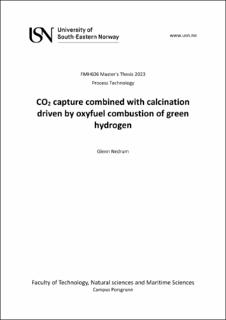| dc.description.abstract | This thesis aimed to investigate the feasibility of incorporating a hydrogen and oxygen production system through electrolysis in a cement plant, specifically targeting the combustion of these gases in a calciner unit for carbon capture of the calcination process. The study was conducted in the context of Norcem Brevik cement plant in Norway, aligning with the goals of the Paris Agreement and the country's emissions targets.
A series of simulations were executed in Aspen Plus to understand the implications of various changes to the calciner system. These modifications included altering coal combustion to match real coal consumption, modifying the adiabatic flame temperature for oxy-fuel hydrogen combustion, and exploring different recycling temperature and flowrate cases for CO2/H2O.
The results from these simulations provided insightful data on the system's energy efficiency, the cooling demand for flue gas, compressor work, and the potential for CO2 capture. The simulations were successful in obtaining desired parameters, providing valuable information for the overall feasibility analysis.
A detailed cost estimation was carried out, considering both CAPEX and OPEX. This analysis was crucial to understand the economic viability of the proposed modifications. The study further investigated the cost per avoided tonne of CO2, an important aspect considering the emerging carbon capture technologies and the CO2 tax implications.
The environmental impact and primary energy losses were also analyzed, focusing on the alignment with emission goals and the potential CO2 emission reduction. This discussion included the prospects of the Longship project for CO2 storage in the North Sea.
A Hazard Identification (HAZID) study was conducted to address potential safety hazards related to the production and utilization of hydrogen and oxygen in the cement plant. This study identified key hazards and recommended appropriate mitigating actions.
The thesis concluded by identifying areas for future research, including the integration of the kiln in the model, and a more detailed investigation of cooling equipment energy usage and cost.
In summary, this thesis provides a comprehensive investigation into the feasibility of integrating oxyfuel combustion of green hydrogen in a cement plant. The findings offer valuable insights for the cement industry and contribute to the broader conversation on sustainable industrial practices and carbon capture technologies. | |



